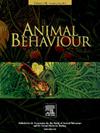雄性丹碱蝶如何定位吡咯利西啶生物碱?前腿是嗅觉生物碱的器官
IF 2.3
2区 生物学
Q2 BEHAVIORAL SCIENCES
引用次数: 0
摘要
大多数雄性丹碱蝶以其奇特的行为而闻名,它们会访问某些特定的植物以获取吡咯利西啶生物碱(PAs),并将其隔离并利用其产生性信息素和化学防御。然而,对于它们定位PA来源的机制以及它们对不同结构类型PA的偏好,目前还缺乏强有力的理解。通过对四种聚羧酸对成虫雄斑天蛾(partica sita, Danainae)的引诱或驱避实验,结果表明,中间胺和番茄胺(I/L)的混合物对其具有显著的驱避作用,而其他聚羧酸(monocrotaline, heliotrine和retronecine)的驱避作用由强到弱表现出较强的驱避作用。相比之下,这些pa对雄性拟opsis similis既不显着吸引也不显着排斥,后者也是一种亲pa的danaine物种。通过对雄鸟触角、前腿(非行走腿)和唇触须作为潜在的pa感受器官的器官消融试验,结合对I/L气味的伸喙反射试验,表明只有这些器官可以检测pa。在这些器官中,前腿,尤其是前肢,似乎主要负责pa的嗅觉感知。对上述两种雄蝶的前肢和另一种已知对I/L具有特异性吸引的danaine蝴蝶Euploea mulciber的扫描电镜显示,它们的前肢表面有壶状感受器。在电生理检查(尖端记录)中,I/L引起了三种物种感觉器的不同反应(尖峰),表明壶腹感器同时具有嗅觉和味觉功能。这些发现表明,雄性不行走的腿在寻找pa的蝴蝶中起着关键作用。本文章由计算机程序翻译,如有差异,请以英文原文为准。
How do male danaine butterflies locate pyrrolizidine alkaloids? The foreleg as an olfactory alkaloid-sensing organ
Most male danaine butterflies are well known for their curious behaviour of visiting some particular plants to acquire pyrrolizidine alkaloids (PAs), which they sequester and utilize for sex pheromone production and chemical defence. However, a robust understanding of the mechanism by which they locate PA sources and their preferences for different structural types of PAs is lacking. An experiment testing the attractiveness or repellency of four PAs to adult male Parantica sita (Danainae) revealed that a mixture of intermedine and lycopsamine (I/L) significantly attracted them, whereas the other PAs, viz. monocrotaline, heliotrine and retronecine, showed potent repellency in decreasing order of intensity. By contrast, these PAs were neither significantly attractive nor repellent to male Ideopsis similis, which is also a PA-phile danaine species. Organ ablation tests in male P. sita on the antenna, foreleg (nonwalking leg) and labial palp as potential PA-receptive organs, carried out in combination with a proboscis extension reflex test in response to I/L odour, indicated that only these organs can be used to detect PAs. Of these organs, the forelegs, especially the foretarsi, appeared to be mostly responsible for the olfactory sensing of PAs. Scanning electron micrographs of the male foretarsi of the abovementioned two species and another danaine butterfly, Euploea mulciber, which is also known to be attracted specifically to I/L, revealed ampullaceous sensilla on their foretarsal surface. In electrophysiological examinations (tip recordings), I/L elicited distinct responses (spikes) from the sensilla of the three species, indicating that the ampullaceous sensilla have both olfactory and gustatory functions. These findings indicate that male nonwalking legs play a key role in PA-seeking danaine butterflies.
求助全文
通过发布文献求助,成功后即可免费获取论文全文。
去求助
来源期刊

Animal Behaviour
生物-动物学
CiteScore
4.60
自引率
8.00%
发文量
236
审稿时长
10.2 weeks
期刊介绍:
Growing interest in behavioural biology and the international reputation of Animal Behaviour prompted an expansion to monthly publication in 1989. Animal Behaviour continues to be the journal of choice for biologists, ethologists, psychologists, physiologists, and veterinarians with an interest in the subject.
 求助内容:
求助内容: 应助结果提醒方式:
应助结果提醒方式:


